How to create an Integrated Weed Managemet Plan
Many Councils are moving away from using Chemicals to manage weeds. Failing to plan, is planning to fail. So how can councils give themselves the best chance of success?
Integrated Weed management Guide
Before you start planning the strategies, understand your current situation
The first thing you need to do, is to understand what is causing weeds to be present in different areas and what factors contribute to the problem.
Initially, it is very helpful to conduct a survey of the assets you look after, such as each road, park, or sports pitch and score each one on a few different factors; Ward maps can be a good way of identifying these assets and you can build up a database that scores each asset on the following criteria.
You can see an example ward map here;
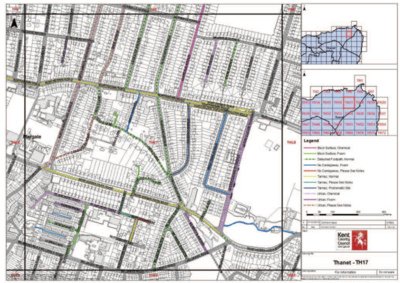
1. Detritus and soil build up.
- On hard surfaces, the build up of detritus is the largest cause of your weed problem. Identify areas where soil has encroached from verges, built up in kerbs or cracks in paving. Score this build up, so you can prioritise the worst areas.
Defra's code of practice for litter and refuse gives a handy scoring tool for detritus, which will assist in this;
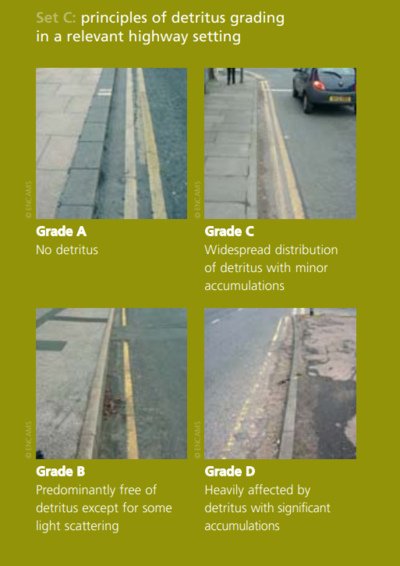
https://assets.publishing.service.gov.uk/media/5d8b766ded915d0372f8ac59/pb11577b-cop-litter1.pdf
Detritus build up should be continuously monitored to determine the necessary frequency and effectiveness of soil removal processes.
2. Sources of detritus
After identifying the detritus levels, we should then identify the worst sources of detritus, so that we can do something to mitigate them later on.
This may be things such as overhanging hedges or trees, verges and other vegetation. Some of this might be marked simply for trimming or cutting and collectiong. In other cases you might want to think about replacing the plants with other low litter varieties or lower maintenance plants. You culd also think about installing some kind of barrier between the plants and the hard surface to prevent migration of detritus.
Some sources of detritus can also be useful.. The material they produce can be recycled as mulch, helping to prevent weeds in other places.
3. Detritus trapment areas
Once we have identified all the sources of detritus, we should assess where it can get trapped. This will include things like cracks at in the surface or pot holes, which might be marked for sealing, or catchment areas such as sharp corners in kerbs. You can see an example of a trapment area here;
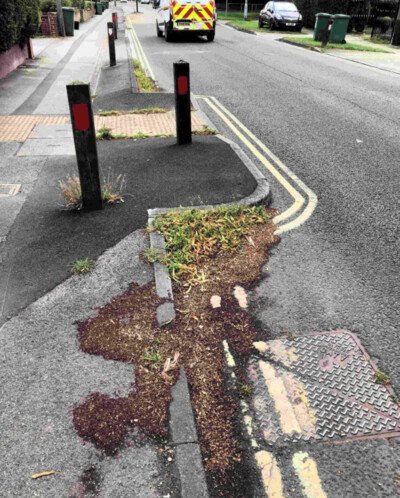
It may be that you simply need to schedule it for more regular cleaning, or cleaning using a different process if the regular sweeping regime is not managing it well enough. Or alternatively, you could thing about re-designing the area slighly to save you effort going forward.
4. Monitor the weed load in these areas.
In order to assess how successful your weed prevention is being, you should score the weed burden in these areas. you should see a dramatic reduction after removing the soil and then working on a few of the other aspects, but tracking the results over time will help identify the ongoing level of treatment you need.
To score the weed burden, you can use the weediness scale in Defra's code of best practice on Weed management for hard surfaces.
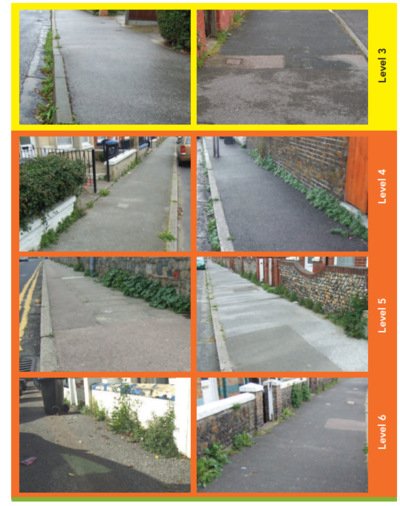
https://kerstenuk.com/files/The-Thanet-Report-Controlling-Weeds-On-Hard-Surfaces.pdf
Deal with the current weed situation
Now you have an accurate picture of the challenges you are facing, it's time to deal with the problems.
1. The most impactful place to start, is removing the existing soil build up.
You should do this by prioritising areas with worst encroachment or build up first.
This is a good winter task, as new detritus will be less and you will have fewer other jobs going on.
By reducing the soil, you will have significantly reduced the weed burden by preventing opportunities for new weeds to grow. You will also change the types of weeds you will need to deal with. Shifting to mainly annuals and mosses, which are significantly easier to kill with thermal methods than perennials and woody plants which require deeper soil to grow.
Below is an example of a weedbrush that can be used for this job;
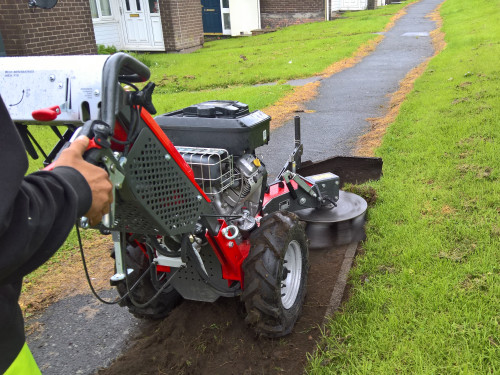
2. Schedule Thermal treatments
Once the soil is removed you can schedule thermal weeding treatments for the early spring to manage weeds that emerge.
I would recommend treating plants at least twice in quick succession (Around 7-10 days apart) for the first treatment. This is because the heat may encourage dormant seeds to germinate, and the second treatment will ensure these are dealt with.
Further treatments may be necessary in certain areas, and monitoring will help to identify areas that need more treatments in the season.
This will generally be determined by the types of weeds you are dealing with. Perennials and woody plants will need more treatments than annuals and mosses. Timing also has a big impact on future weed burden. Killing the plants early will prevent them going to seed, which will greatly reduce the future effort required to manage the weeds.
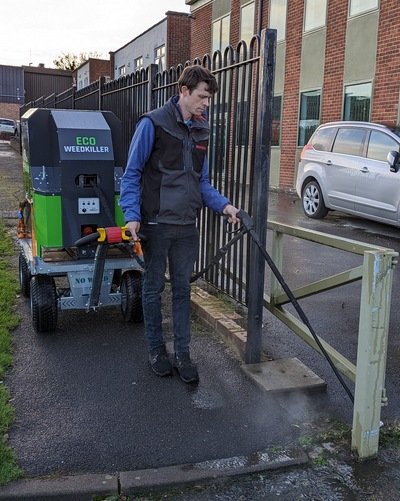
Above is an example of a Hot water Weeding tool, which allows easy treatment on pavements.
3. Schedule sweeping to follow weed treatments
Keeping on top of detritus build up with a sweeping regime is important. Remember that any weeds killed will lead to detritus on the hard surface, therefore a well timed sweep will ensure this is removed before it becomes soil.
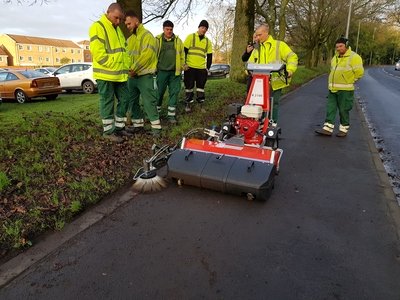
4. Pick off the other jobs you have identified to reduce detritus build up
Once the essentials are done, you will be in an improved situation, but you can make your life easier and reduce the number of treatments significantly by further reducing the sources of detritus. As areas are re-developed, new planting regimes can be used to encourage lower levels of shrub litter, or reduce the grass cutting schedule by using more ground cover plants.
Not only will this reduce your detritus and therefore save on some of the sweeping and thermal treatments - you might also save money on things like grass cutting and pruning plants, resurfacing pavements and sealing cracks.
These blogs might be useful in helping to plan this;
Additional things you can do to increase your IWM Plans success
An Integrated Weed Management Champion
In some councils, it will require a joined up effort between different departments to look after different assets. Sometimes different councils might be responsible for the pavement and the verge on the same stretch of road. This requires communication to overcome. It is also helpful to communicate the plan with the community. Sometimes you may require their help with moving cars, and volunteers with hoes and brooms are often a good resource for certain areas. A weed management champion can help to liaise with the public to maximise the effectiveness of your efforts.
Some councils, such as Lambeth have had great success with community weeding schemes to help lighten the burden on the council.
You can find more information on Integrated Weed Management here;
https://kerstenuk.com/integrated-weed-management-for-amenity
No comments yet. Login to start a new discussion Start a new discussion